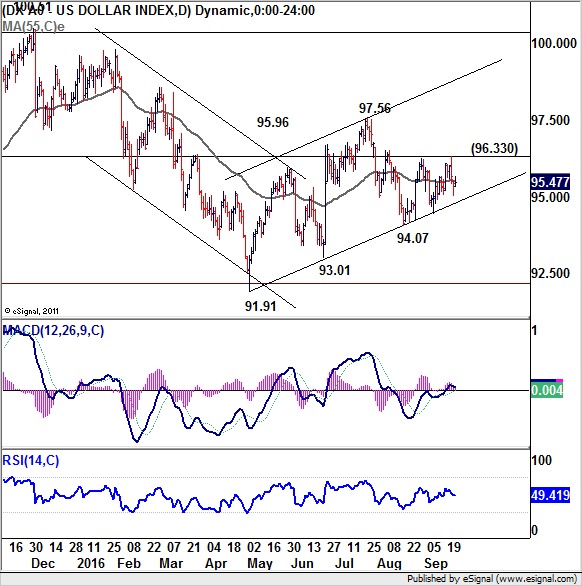Dollar weakened broadly last week after Fed stood pat and revised down interest rate projections. Nonetheless the greenback pared back some losses as markets were still expecting another rate hike in December. Also, the selloff in Dollar was overwhelmed by Sterling and Kiwi as BoE and RBNZ are expected to cut interest rate again later this year. Meanwhile, Australia dollar ended the week as the strongest major currency as stocks rebounded on global interest rate expectations. Yen also jumped after BoJ announced revision of the policy framework without additional stimulus. In other markets, US stocks rebounded strongly after FOMC but lost momentum towards the end of the week. US yields also dropped sharply post FOMC. Meanwhile, gold jumped on Dollar's weakness and ended higher while crude oil struggled to sustain gains.
To recap the central banks activities, Fed left its policy rate unchanged at 0.5%. The accompanying statement unveiled a more divided committee with 3 members voting for a rate hike while another 3 lowered their 2016 dot to support no rate hike this year. The Fed delivered a more hawkish message, both in the statement and in Chair Yellen's speech at the press conference, expressing confidence in the economy. We note 2 major changes in the statement language. First, the members acknowledged that near-term risks to the economic outlook 'appear roughly balanced'. Second, the Committee 'judges that the case for an increase in the federal funds rate has strengthened'. We see both strongly signal that the Fed is planning for a rate hike in the coming meetings. Despite being increasingly hawkish, the Fed has pushed down the path of interest rates over the medium term. Besides signaling only one rate hike this year, the median expectation for 2017 has dropped to 2 hikes from 3 hikes previously, whilst maintaining 3 hikes in both 2018 and 2019. More in Fed Keeps Powder Dry, In Face Of A More Divided Committee.
BOJ introduced a new policy framework, the 'QQE with Yield Curve Control', in order to achieve the inflation target of 2%. The framework consists of two major components: 'yield curve control' and 'inflation-overshooting commitment'. For the first component, BOJ would control short-term and long-term interest rates, while, for the second one, BOJ commits to expanding the monetary base until the year-on-year rate of increase in the observed CPI exceeds 2%, and stays above it in a stable manner. BOJ refrained from cutting the policy rate further from the current -0.1% and left the annual pace of increase in the amount outstanding of its JGB holdings at about 80 trillion yen. The policy change indicates that BOJ has shifted from 'monetary base' targeting to 'nominal yield curve' targeting. More in BOJ Shifts Policy Framework To Nominal Yield Curve Targeting.
RBNZ left the OCR unchanged at 2% in September but reaffirmed the dovish tone in the post-meeting statement, signaling a cut in November is still on. The central bank warned that the excessive housing price inflation is posing concerns for financial stability. Yet, it added that recent macro-prudential measures are taking their effects. Despite recent improvement in exports, RBNZ continued to warn over kiwi's appreciation, noting that 'a decline in the exchange rate is needed' More in RBNZ Kept Rates Unchanged, Door Remains Open For November Cut.
RBA's minutes for the September meeting indicated that the central bank was content with the current monetary policy stance, with the cash rate at 1.5%. Policymakers acknowledged that the economy has been growing in line with potential. The members 'observed that the data for the international and domestic economies over the past month had been broadly consistent with the forecasts'. Moreover, 'forward-looking indicators had been consistent with only a slight change in the unemployment rate in coming months. Domestic cost pressures, including wage growth, had remained low and were expected to remain so for some time'. More in RBA Minutes Signal Further Easing This Year Less Likely.
Dollar index failed to sustain above 96.25 resistance despite a brief breach. Nonetheless, the index continued to struggle in tight range around a flat 55 days EMA. Near term outlook is neutral for the moment. The index is staying inside near term rising channel from 91.91 even though the rise is having a corrective structure. Above 96.33 will target 97.56 but we'd be cautious on strong resistance above there to limit upside. Meanwhile, break of 94.07 support will carry bearish implication and would likely extend the fall from 100.51 through 91.91 support.

Regarding trading strategies, we closed our EUR/AUD at 1.4901 last week (bought at 1.4891) with a small profit. The decision was correct as the cross dipped sharply to as low as 1.4629 then. Meanwhile, we sold GBP/USD at 1.2997. In spite of intra week rebound to 1.3120, the pair resumed the fall from 1.3444 since then with initial bias staying on the downside this week. We maintain the bearish view that GBP/USD's consolidation from 1.2794 is completed with three waves up to 1.3444 and anticipate a test on 1.2794 in near term. And break will extend the larger down trend to next projection level at 1.2457. Hence, we'll stay short and GBP/USD but put a tight stop at 1.3120 to guard against rebound ahead of 1.2794 low.
